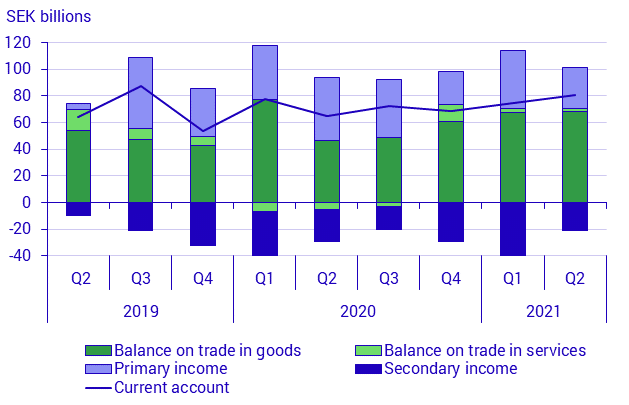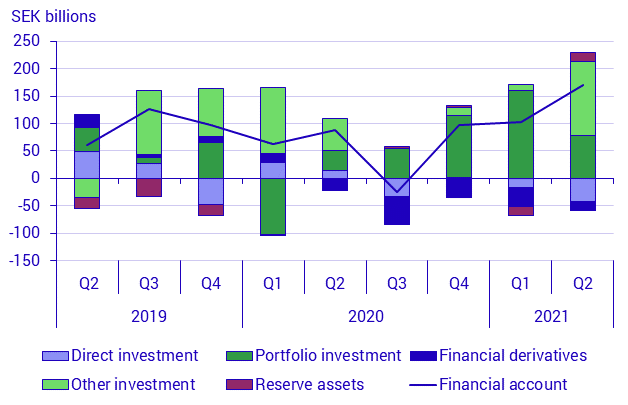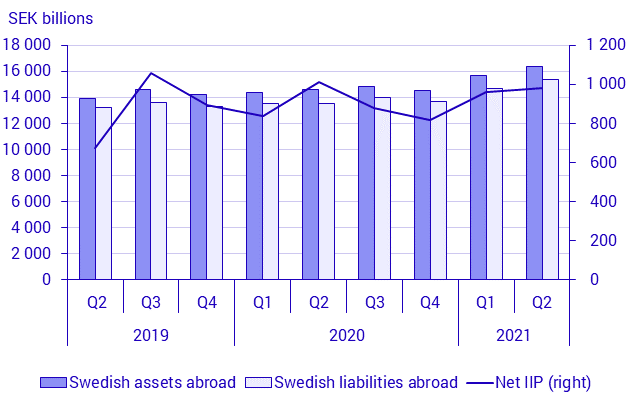Balance of payments, 2nd quarter 2021
Trade in goods recovery increased Sweden’s current account surplus
Statistical news from Statistics Sweden 2021-09-03 9.30
The current account surplus amounted to SEK 80.3 billion in the second quarter 2021, which is an increase of SEK 15.5 billion compared with the second quarter of 2020. Exports and imports of goods and services recovered compared with a year ago, and trade in goods has returned to pre-pandemic levels.
The financial account shows that net lending with the rest of the world amounted to SEK 170.6 billion during the second quarter. Sweden’s net external assets position, presented in the international investment position, was SEK 979.0 billion at the end of the second quarter of 2021.
New data sources have been used to compile Sweden’s net external position for holdings of portfolio investments in the second quarter of 2021. This affects any comparison with previous periods. For further information, see below in New data sources for portfolio investments.
What is the balance of payments?
The balance of payments is a statement of all Swedish transactions with the rest of the world. It presents exports and imports of goods and services, and includes a description of changes in financial assets and liabilities with the rest of the world. The balance of payments consists of the current account, the financial account, and the capital account. The component parts of the balance of payments and related terms are explained under Definitions and explanations, at the end of this item of statistics news.
Current account surplus as share of Sweden’s GDP increased
Sweden’s current account as a share of GDP increased somewhat and was 5.7 percent of Sweden’s GDP in the second quarter of 2021, calculated as an average over the last four quarters. This proportion has been at similar levels since the fourth quarter of 2020.

Comparisons between periods in the current account are made using the corresponding quarter the previous year.
Trade in goods surplus increased
The balance on trade in goods recorded a surplus of SEK 68.3 billion in the second quarter of 2021, which is an increase of SEK 21.6 billion compared with the second quarter of 2020. Goods exports amounted to SEK 458.1 billion, up by SEK 97.2 billion compared with the corresponding quarter a year ago. Goods imports amounted to SEK 389.7 billion, up by SEK 75.5 billion in a corresponding comparison.
Surplus in merchanting, which is included in the balance on trade in goods, increased by SEK 2.6 billion compared with the second quarter of 2020. The surplus thus amounted to SEK 31.7 billion in the second quarter of 2021.
Services account surplus increased
The services account noted a surplus of SEK 1.9 billion. This can be compared with the deficit of SEK 4.9 billion in the corresponding quarter a year ago. Services exports amounted to SEK 159.4 billion, up by SEK 18.6 billion compared with the second quarter 2020. At the same time, imports of services amounted to SEK 157.5 billion, up by SEK 11.8 billion in a corresponding comparison.
Primary income surplus decreased
Primary income, which consists mainly of compensation of employees and investment income, presented a surplus of SEK 31.3 billion in the second quarter of 2021. This is a decrease of SEK 16.0 billion compared with the corresponding quarter a year ago. Return on capital is the part of primary income that mainly contributed to this change through a decreased surplus. The surplus in return on capital went from SEK 44.0 billion in the second quarter of 2020 to SEK 28.6 billion in the second quarter of 2021.
Investment income on portfolio investment led to the decreased surplus in return on capital. This is mainly due to a recovery for Swedish dividends in the second quarter of 2021 compared with the corresponding quarter a year ago, when many Swedish enterprises refrained from issuing dividends due to the effects of the pandemic. However, Swedish dividends have not returned to pre-pandemic levels.
Investment income on direct investment contributed a surplus of SEK 21.6 billion, up by SEK 3.5 billion compared with the second quarter of 2020.
Secondary income deficit decreased
Secondary income, which includes international cooperation and donations and contributions to the EU, noted a deficit of SEK 21.3 billion. This deficit narrowed by SEK 3.0 billion compared with the corresponding quarter a year ago.
Net lending in the financial account
The financial account noted net lending amounting to SEK 170.6 billion in the second quarter of 2021. Net lending and net borrowing refer to the overall balance of the financial account.
In the financial account, other investments, portfolio investments and reserve assets noted net lending, while direct investments and financial derivatives noted net borrowing.

Direct investments increased in Sweden and abroad
Net borrowing in direct investment amounted to SEK 42.1 billion during the quarter. Foreign direct investment in Sweden increased by SEK 72.8 billion and Swedish direct investment abroad increased by SEK 30.7 billion.
Portfolio investments increased both abroad and in Sweden
Net lending in portfolio investment amounted to SEK 78.7 billion during the quarter. Swedish investors increased portfolio investments abroad by SEK 107.0 billion, and foreign investors increased portfolio investments in Sweden by SEK 28.3 billion.
Other investments increased abroad
Net lending in other investment corresponded to SEK 133.5 billion. Swedish other investments abroad increased by SEK 129.6 billion, while foreign other investments in Sweden decreased by SEK 3.9 billion.
Financial derivatives and reserve assets
Net borrowing in financial derivatives amounted to SEK 16.8 billion. Reserve assets noted increased net lending corresponding to SEK 17.3 billion.
Sweden’s international investment position
New data sources have been introduced for holdings of portfolio investments in the second quarter of 2021. This affects any comparison with previous periods. For further information, see below in New data sources for portfolio investments.
Sweden’s net external assets position was SEK 979.0 billion at the end of the second quarter of 2021. The largest net external assets were noted in other investment, reserve assets, and direct investments. The largest net liabilities were noted in portfolio investments. Swedish external assets amounted to SEK 16 367.9 billion. Swedish external liabilities amounted to SEK 15 388.9 billion.

New data sources for portfolio investments
New data sources for the balance in portfolio investments have been introduced as of the current publication on the second quarter of 2021. The data is retrieved from the database on securities holdings (VINN) and the Swedish securities database (SVDB) rather than as before, via separate collections. This will lead to a break in the time series between the first and second quarter of 2021. In connection with the publication of the third quarter of 2021, the first quarter of 2021 will be revised based on the new data sources.
The change of data sources will lead to an increase in the levels of Swedish holdings in portfolio investments abroad and foreign holdings in Swedish debt securities, as the VINN and SVDB databases have a higher degree of coverage than previous collections. The data source for foreign holdings in Swedish shares and funds, that is, Statistics Sweden’s shareholder statistics and fund statistics, will remain unchanged.
Income on portfolio investments in the second quarter of 2021 is calculated, as before, by applying the combined indices that show the progression of income for various markets on balances. As the balance levels rise, this also leads to some level increases on income.
Transactions in portfolio investments were not affected in the current quarter by the change of data source. Data from VINN and SVDB on transactions will be introduced in connection with the publication of the third quarter of 2021.
Statistics Sweden plans to gradually continue work on the time series.
For more information: New data sources for statistics on securities - 20210825
Revisions
The time series for the Balance of Payments and the international investment position has been revised from Quarter 1 2019.
The Balance of Payments adheres to a predetermined revision policy, see Section 2.3 in the 2021 Quality Declaration."Kvalitetsdeklarationen 2021 (pdf)".
In a compilation of the balance of payments and the international investment position, data based on forecasts are used in some cases. The statistics will be updated as results are received. If new data is added or in the case of any methodological changes, further revisions are carried out as necessary.
Revisions carried out in connection with publication of the second quarter 2021 are listed in the tables on revisions by account item for the balance of payments and the international investment position respectively.
Definitions and explanations
The current account and the financial account record real and financial transactions with regard to the rest of the world. Only proper transactions are recorded; value changes, such as exchange rate fluctuations are excluded.
The current account shows the trade in goods (foreign trade in goods), the trade in services (foreign trade in services), primary income (compensation to employees, investment income, other primary income), and secondary income (current transfers). Surplus and deficit in the current account refer to the difference between Sweden’s exports and Sweden’s imports. A positive outcome results in a surplus, while a negative outcome results in a deficit. Comparisons between periods in the current account are always made using the corresponding quarter the previous year, due to seasonal patterns in data.
The financial account consists of direct investment, portfolio investment, financial derivatives, other investment, and reserve assets. Sweden can acquire and dispose of financial assets abroad. All transactions during the quarter concerning external assets show Sweden’s change in net external assets. Sweden can also borrow and repay financial external liabilities. All transactions during the quarter concerning external liabilities show Sweden’s change in net external liabilities. The difference between Sweden’s change in net external assets and Sweden’s change in net external liabilities can be positive or negative, and shows net lending and net borrowing, respectively.
The capital account records Sweden’s capital transfers and transfers of non-financial assets with regard to the rest of the world. Compared with other parts of the balance of payments, amounts in the capital account are usually small.
The difference between Sweden’s financial external assets and liabilities position is the net of Sweden’s international investment position, which can be positive or negative.
An increase or decrease in assets describes Sweden’s external assets. An increase or decrease in liabilities describes Sweden’s external liabilities.
Merchanting, which forms a part of the trade in goods, refers to triangular trade in which goods are purchased and sold abroad without the good crossing a Swedish border.
Statistical Database
More information is available in the Statistical Database
Feel free to use the facts from this statistical news but remember to state Source: Statistics Sweden.
